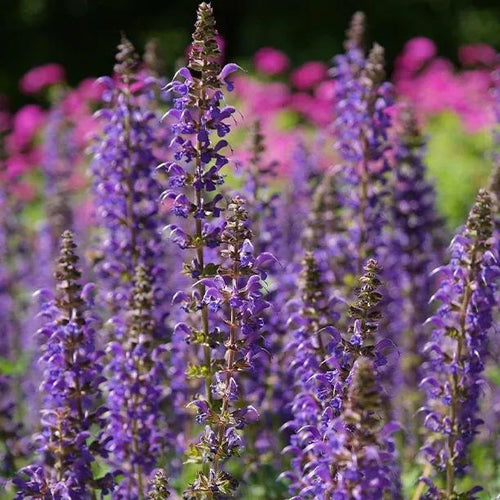Caradonna Sage Plants
Caradonna sage is a bestseller due to her reliable, fairly long flowering season of vivid, rich purple-blue flowers that stand out from the dark purple flower stalks, waving in the breeze over the grey-green deciduous foliage. To 50cm tall.
Browse our range of Salvia varieties or all of our perennial plants.
Features
- Colour: Violet-blue flowers on deep purple stems.
- Flowering: June-October
- Foliage: Mid green
- To 50 x 30cm
- Full sun, sheltered site
- Any well drained soil, likes chalk
- RHS Plants for Pollinators
- RHS Award of Garden Merit
Growing Caradonna Sage
Salvias need close to full sun, and will grow near the coast in exposed locations. They're fully hardy, although their flowering season will be shortened somewhat in cold and windy places. They're happy on chalk, and like a light, well-drained but moist soil enriched with humus that doesn't remain wet in winter, so heavy clay isn't good. They're perfect for a Mediterranean or gravel garden, and are great in large containers. Established plants are drought resistant, but still want fairly consistent moisture in dry summer periods to flower really well.
They're perfect for a Mediterranean or gravel garden, and are great in large containers.
Deadhead promptly to get the most from the flowering season. Leave the withered foliage on the plants overwinter for protection, and trim them after the last spring frost, right down to new growth.
Mulch lightly every year or two, ideally after a heavy spring rain when the soil has warmed up. Salvias don't need much fertility, so a little help goes a long way.
Garden Design Ideas
A salvia ... dear ... to garden designers. She is as comfortable in a traditional herbaceous border as she is in a contemporary Piet Oudolf style prairie scheme. The rich dark flowers would look good combined with stipa tenuissima and a few pink penstemons such as Hidcote Pink or Evelyn. Alternatively, for a really lovely English cottage garden look, combine with a blousy, scented rose.
There are great swathes of Salvia Caradonna at RHS Garden Wisley in Surrey, paired with pale pink roses and dark purple heuchera. To replicate this, we suggest Rosa Bonica combined with Heuchera 'Obsidian'.
History & Trivia
Commonly known as Balkan Clary or Woodland Sage and was formerly classified as Salvia x sylvestris. Caradonna is easily understood as Dear Lady in Italian, and that was probably the intention when naming this Salvia, however, it also a Calabrian surname, a variant spelling of Ceradonna, which is a frazione, village district, of the joint municipality of Corigliano-Rossano, which was established by referendum in 2018.

 Secure, One-Tap Checkout
Secure, One-Tap Checkout
 Hand Picked, Delivered to Your Door!
Hand Picked, Delivered to Your Door! 1 Year Bareroot Guarantee
1 Year Bareroot Guarantee